How Easy is It to Stain a Fence
Staining a fence is an easy DIY Painting project that nearly anyone can tackle.
All you need are some basic painting tools, a power washer (which you can rent), and some free time.
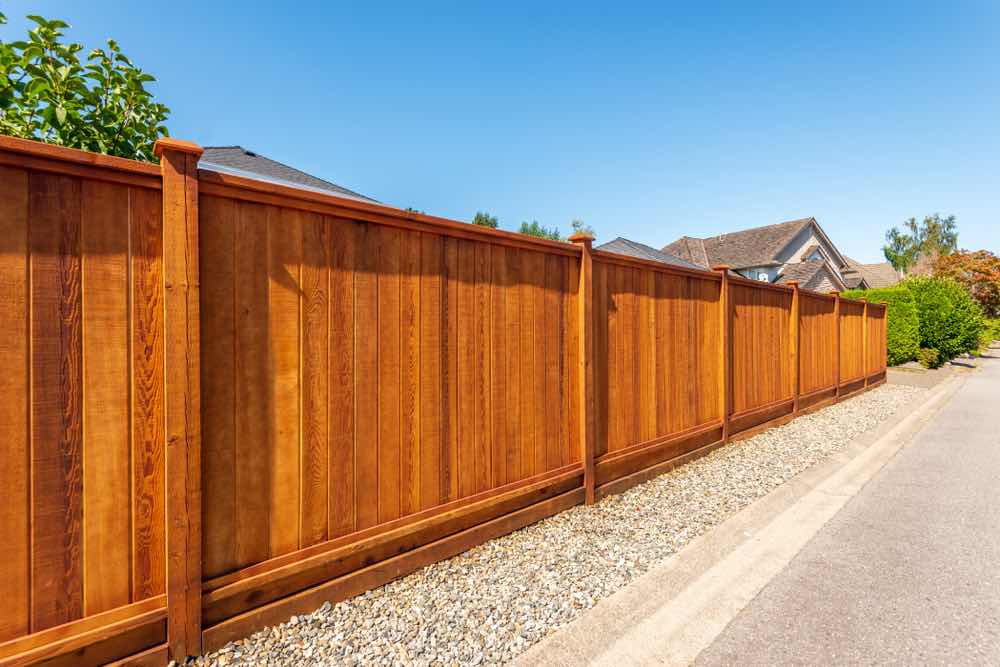
In this post, I am going to cover everything you need to know to not only get your fence stained, but how to do it quickly, efficiently, and have a finish that will last for years.
Here's How To Stain A Fence
- Before You Begin
- Preparing The Fence For Staining
- Staining Your Fence
- Staining Your Fence Using A Sprayer
- How Long Will My Fence Stain Last
Before You Begin
Before you dive right in and begin slapping stain onto your fence, you're going to need to do some planning.
If you'd like to know roughly how long it takes to stain a fence or how much it costs to stain a fence, I've got a post covering both of these here: How Much Does It Cost To Stain A Fence?
Tools You Will Need
- 4″ Stain Brush
- 9″ Paint Roller and Roller Pad
- Extension Pole
- Paint Tray
- Drop Cloths
- Moisture Meter (Optional)
- Pressure Washer
- Garden Hose
- Exterior Wood Stain
- Wood Cleaner and Wood Brightener (optional)
Check The Weather
Before you begin any exterior staining project, it is always a good idea to check the weather. Most fence stains require the forecast to be free from rain for roughly 24 hours. If your stain gets rained on before it is ready, it can create water spot marks in the finish.
As long as rain isn't expected during the day and the night after you apply your stain, you should be perfectly fine.
Prepping Your Fence For Staining
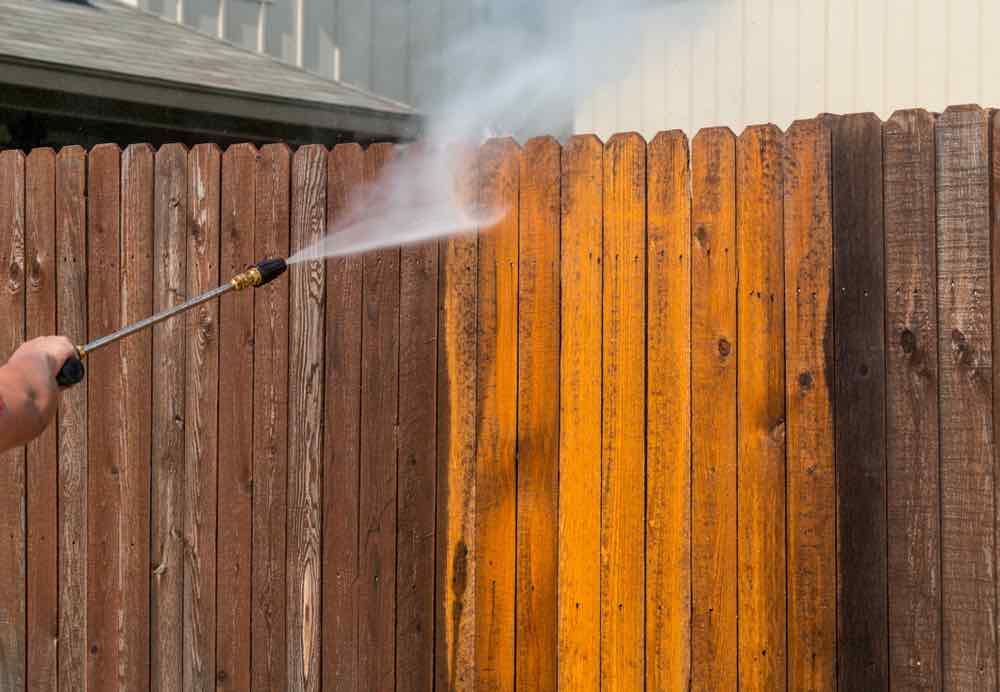
As with most staining and painting jobs, prep work is usually a very large part of the job and can make or break the results.
Good prep work will lead to a beautiful looking and long lasting stain finish on your fence, so don't skimp on your prep work.
Power Washing, Fence Cleaner, and Brightener
If you go into any paint supply store like Home Depot or Sherwin Williams, chances are that they are going to sell you on the idea that you need to buy a wood cleaner and a wood brightener.
Personally, I don't really believe that wood cleaners and brighteners are all that useful. They introduce harmful chemicals into your lawn and drive up the price of your project.
These stores, as well as many websites, will try to scare you that you can do a lot of damage power washing your fence (or deck for that matter) and that you should avoid using a power washer.
The truth of the matter is that 99% of people power washing won't have a power washer that is strong enough to really damage your wood. Even if you did run a large power washer that could damage the wood, properly using it will result in clean wood, not damaged wood.
Most homeowners have electric power washers or small gas-powered power washers. These washers are not typically powerful enough to damage your fence unless you really misuse them.
So my official recommendation is to power wash your fence.
I like to use either a 25 or 40 degree nozzle. This refers to how wide of a spray fan the tip will produce. The wider the fan, the more coverage you'll get when cleaning and the less damage you could potentially do to your wood. So, a 45 degree tip is usually a safe choice for most people.
When power washing your fence, make sure to go slow, take multiple passes and work each fence board until the previous stain, greying and debris has been thoroughly removed.
Dry Time
After you finish power washing your wood fence, you'll need to make sure that it is thoroughly dry before you begin applying stain.
If the moisture content of the wood is too high, your new stain may peel prematurely and not adhere properly to the wood fence.
Most stain manufacturers recommend that the moisture content of the wood be no more than 15%.
The only way to be 100% positive that the moisture is 15% or lower is to use a moisture meter. A moisture meter is a device that has two metal tips pointing out. Simply stick those into the wood and it will tell you the moisture reading of the wood.
Typically, depending on the exterior humidity, it should take 24-48 hours to get the moisture content of the wood low enough to begin staining.
If you don't have a moisture meter, or don't want to get one, just give your fence a good 48 hours during moderately low humidity and you should be perfectly fine.
Staining Your Fence
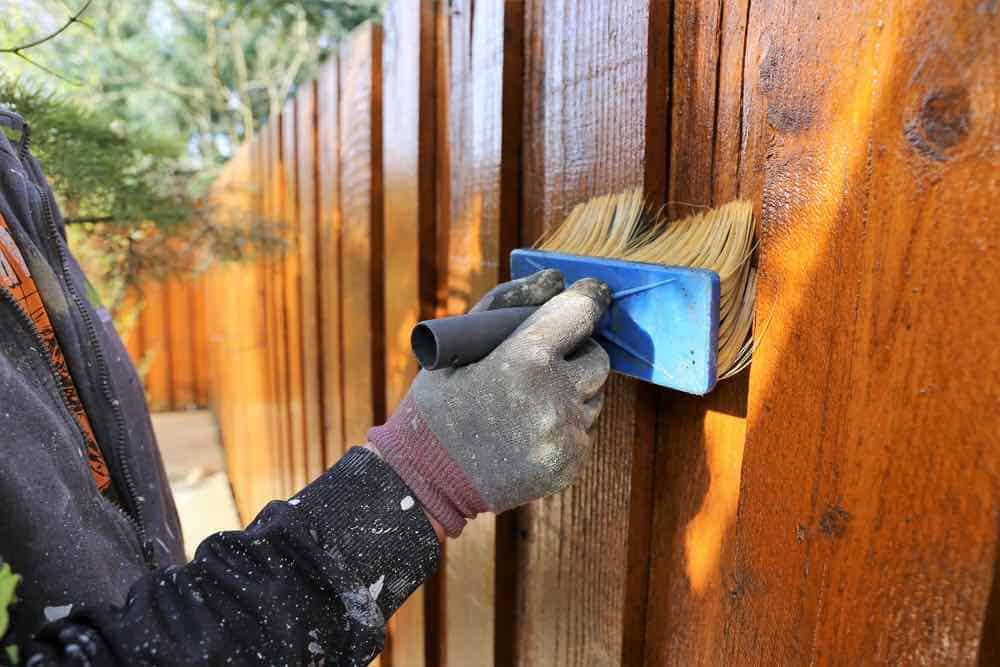
After you finished cleaning your fence and it has had proper time to dry, it's time to bust out the wood stain and start applying some stain!
When I'm staining a fence I like to drag along a 4′ x 12′ drop cloth. Even if your fence only has grass under it, a drop cloth can be nice to help keep the grass from getting in the stain and sticking to the fence. It's also great for preventing splatter on driveways and anything else you need to keep clean.
Mixing Your Stain
You may have heard that it is a good idea to "box", or mix together, all of your paint when painting an interior to help ensure that colors are 100% the same from gallon to gallon. I do not believe this to be necessary at all when staining a fence. On the off chance that one can of stain has a slight variation from another, you will never be able to tell on an exterior fence. Don't worry about mixing your stain.
Brushing And Rolling Your Fence Stain Onto Your Wood Fence
It's Not time to apply the stain. For most people, brushing and rolling fence stain is the way to go.
I like to pour 3/4 of my stain into a large handy paint tray and keep 1/4 of it in the bucket for brushing the tops of the fence boards and edges.
I've found that completing roughly 6′ or 1 section at a time, start to finish, is the best way to go. Also, ideally, you should avoid staining a section of fence that is in direct hot sunlight.
Pro Tip: Staining in the shade will be more comfortable for you and help the stain dry slower and avoid lap marks (areas where the stain dries and overlaps, creating a darker line of stain).
Start by taking your 3″ deck brush and brushing all of the tops, edges and hard to reach areas with stain.
After you have hit all of the hard to reach areas with your brush, get out your 9″ roller and extension pole.
An extension pole will save your arms and back a great deal of pain after a full day of rolling stain onto your fence. We have a great guide all about paint extension poles to help you find the best one.
I like to use a 3/8″ nap roller when I am staining fences. Since stain's viscosity (thickness) is more like water, you actually don't want too much in your roller at a time or you will end up with a lot of runs.
After you are done rolling out a section of the fence, double-check for runs. If you find any, simply brush them in with your 3″ brush.
Note: If you find that rolling the stain onto your fence with a 9″ roller frame and 3/8″ roller pad isn't working for you, or the fence is built in such a way that a roller doesn't work, go ahead and brush out the stain with your stain brush and skip using a roller. Some people find a roller to be messy and frustrating. A brush will be slower, but it is much easier to control.
Learn How to Stain A Deck Here and find The Best Deck Stains.
How To Stain A Fence Using A Sprayer
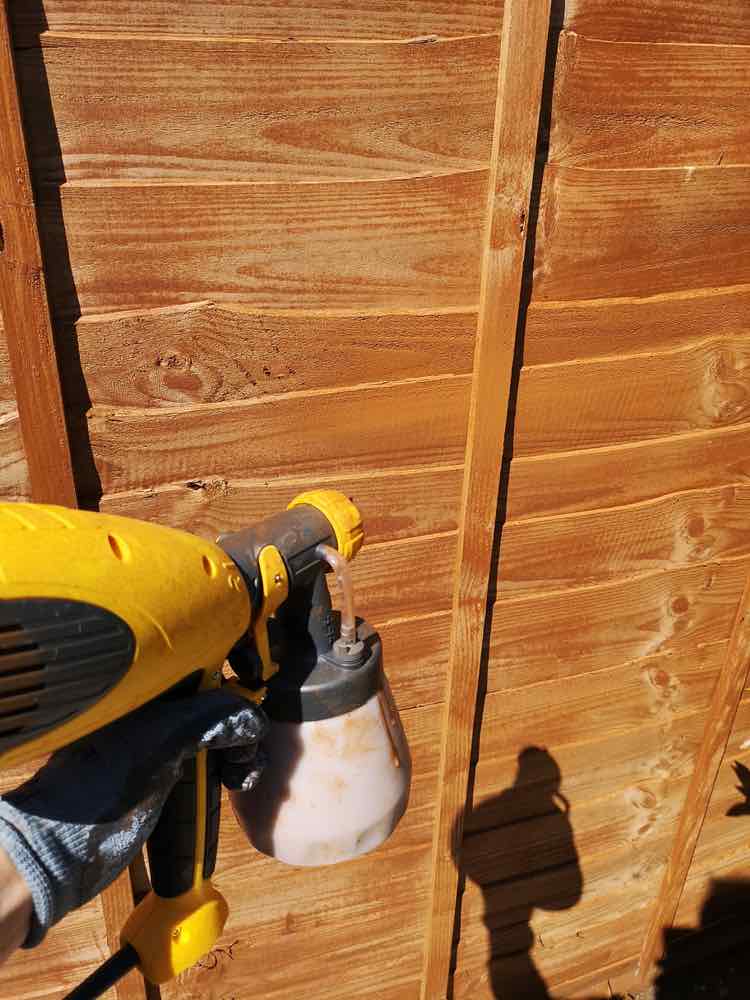
If you want a fence staining solution that is fast and will produce a great looking fence, then you may want to try spraying the stain onto your fence.
Spraying stain onto a fence vs brushing or rolling, can literally be over 5X faster. For example, a two day stain job can often times be but down into one afternoon if you decide to spray the stain onto your fence.
There are a few things you should be aware of when spraying to ensure a good experience.
Think About Where The Overspray Will Go
A sprayer breaks the stain down into tiny droplets that can float a very far distance and land on anything from cars to houses to deck furniture.
Make sure the wind is flowing in a favorable direction when spraying and go the extra mile on your prep work.
Note: water based stain will usually be dry after traveling in the air for roughly 10 feet. Anything it lands on after that, it won't stick to and you will be able to wipe it off like dust. Oil based stain, on the other hand, can travel much further distances and still stick like glue to surfaces. So beware of oil based over-spray.
Spraying Adds Extra Expenses
Buying or renting a sprayer will add an extra expense. A great budget sprayer for staining fences is the Wagner Opti-Stain Handheld Sprayer.

Spraying also results in more over-spray which means paint that goes into the air and not onto the fence. You can usually plan on 30% of your stain being wasted when spraying.
Spraying Requires A Bit Of Practice (but you can do it!)
It can be easy when spraying stain to get too much or too little stain onto the wood.
Too much will result in runs while too little stain will result in a patchy looking finish.
Start in the most secluded area of your fence, by the time you get to more prominent areas, you should have a good feel for your sprayer.
Pro Tip: I like to take a 4″ stain brush and quickly brush in my stain after I spray it onto the fence. This adds a little bit of time, but it helps to even out the stain after I spray and push the stain into the pours of the wood.
How Long Will My Fence Stain Last
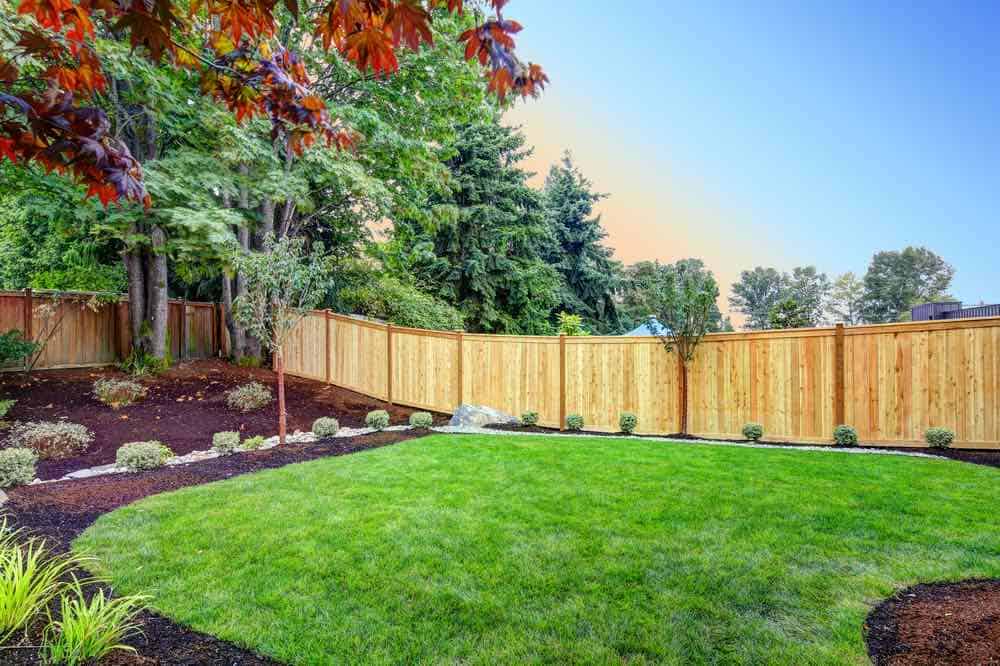
Congratulations on completing your DIY Fence Staining Project!
Now that you're done, you might be wondering how long before you'll have to do this project again?
That's a valid question.
Thankfully, 90% of the wood on fences is verticle facing unlike all the horizontal boards on a deck. Fences also don't have to deal with foot traffic.
If you did your prep work right and used a quality product, fence stain no less than 5 years and potentially up to 15.
If you completed a fence staining project or if you have any questions, let me know in the comments below. I make sure to respond to everyone!
Source: https://diypaintingtips.com/how-to-stain-a-fence/
0 Response to "How Easy is It to Stain a Fence"
Post a Comment